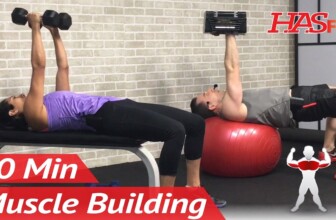Pro: Exercises to Help Prevent Osteoporosis
Osteoporosis is a silent disease that develops over many years and affects 10 million people. Join Robyn Stuhr, ACEs Executive Vice President, in this Pro News video feature to learn about some key types of exercises that can increase bone strength and prevent the disease.
Robyn Stuhr: Hi. I'm Robyn Stuhr with the American Council on Exercise with some important information about exercise and bone health. Did you know that half of all women, and up to 20 percent of men, will have an osteoporotic fracture sometime in their lifetime? Osteoporosis is a disease that's characterized by low bone mass or density, and poor bone strength. And common sites for osteoporotic fracture include the wrist, hip, and the spine. But the good news is that we can prevent osteoporosis by the right kinds of exercise and a good diet. Now, there are two types of exercise that are critical for healthy bones. The first is strength training, or resistance exercise, and the second is weight-bearing exercise, particularly jumping or plyometric types of exercise. Now, when it comes to a strength-training program, a well-rounded program is essential because exercise is site-specific when it comes to the bones' adaptation. So, the muscles pull on their bony attachments, stimulating the bone to grow in that particular bone. So, a well-rounded program, particularly using free weights, is terrific because you're standing and using the muscles in the legs to push into the ground for balance, and the muscles along the spine are activated for balancing and stabilizing. For example, a lunge, whether done in reverse position (which you see here) or walking, involves the legs, and when she adds the dumbbells, involves the arms. It's important to keep your shoulders relaxed, your stomach pulled up and in, and keep the front knee over the foot. Don't let it go beyond the toes. Jumping activities are great for building bone strength in the hip. However, if you've already been diagnosed with osteoporosis, or have osteoarthritis of the hip or knee, do not do these kinds of activities. You can start with something simple such as a side-to-side one-footed hop, making sure that you land softly on the ball of the feet, and pretending like the floor is hot so you spring up as quickly as you can. You can then move to something like two-footed jumping. Starting with your feet shoulder-width apart, bringing your arms back, and jumping up as high as you can, trying to get height and strength with the jump. And, again, pretend like the floor is hot. You can then transition to diagonal jumps, because this surprises the bone with different trajectories of force and can improve bone strength. Make sure your client keeps their knees over their feet, lands soft, with the stomach pulled in and tight. A more advanced exercise involves jumping off a box, explosively going as high as you can, but being soft on the landing with the knees over the toes. This is great for kids and young, healthy adults to really improve that hipbone mineral density. Now, with all of these jumping exercises, you want to start off with just five to 10 repetitions and build up to 50 to 100 three times a week, using a lot of variety and changes of direction, different angles, different types of jumps: two-footed as well as one-footed. Another exercise that's great for posture and the spine is the upright row. Make sure you keep your shoulders down and relaxed, squeeze the scapula together as you pull the weights back, and keep the core activated, pulling the tummy in. You can also bring the legs into the picture by doing a partial squat, making sure the buttocks goes out and back first as you initiate the movement and keeping the knees over the feet. Although you'll see the greatest adaptations to bone strength from high-intensity, high-challenge strength training, and high-impact, lots-of-variety movement aerobic training and jump training, it's important to start where you and your client are and take into account their individual level of musculoskeletal and overall fitness. Just get moving. For more information, go to acefitness.org.
#Pro #Exercises #Prevent #Osteoporosis
source
At 4utoday, we are your ultimate destination for the best deals, offers, coupons, articles, and reviews. Our platform provides a wide range of discounts and promotions on various products and services.
With a dedicated team searching the web, we bring you the most exciting savings. Our informative articles and reliable reviews help you make informed decisions. Join us on our journey to discover incredible savings and make smarter shopping choices.
With a dedicated team searching the web, we bring you the most exciting savings. Our informative articles and reliable reviews help you make informed decisions. Join us on our journey to discover incredible savings and make smarter shopping choices.
Affiliate Disclaimer:
At 4utoday, we may participate in various affiliate marketing programs. This means that we may earn a commission from qualifying purchases made through the links, advertisements, or promotions on our website. The commissions we earn help support the maintenance and operation of our platform, allowing us to continue providing you with the best deals, offers, coupons, articles, and reviews.
Rest assured that this will not affect the price you pay for any products or services you purchase. We strive to provide honest and reliable information, and our recommendations are based on our own research and experience. We appreciate your support and trust in our recommendations.
Rest assured that this will not affect the price you pay for any products or services you purchase. We strive to provide honest and reliable information, and our recommendations are based on our own research and experience. We appreciate your support and trust in our recommendations.











This is the first ACE video that I disagree with!
1. The bone response to exercise changes: pre-puberty; puberty to pre-menopause; post-menopause. So the exercise prescription has to be different for each of these groups and is different again if osteoporosis is diagnosed.
2. Strength training does little, if anything, to increase bone mineral density. To increased or maintained bone density:stomp;hop;jump; skip;line dance.
3. 20 jumps or skips twice a day every day is a good way pre-menopause.